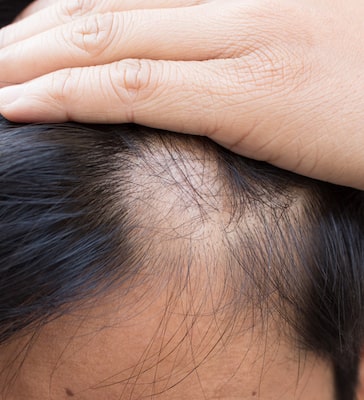The word “alopecia” can be viewed as kind of an umbrella term for conditions that are characterized by hair loss. One of the most common types of alopecia is Alopecia Areata which is an autoimmune disease. However, not all forms of alopecia are related to a condition that occurs due to an unusual response made by the immune system. For instance, there are some alopecia conditions that are caused by lifestyle or genetic factors as well as psychological conditions. The treatment option depends on the type of alopecia that is being addressed.
Alopecia – Overview of the Different Types
 Alopecia Areata – As mentioned above, alopecia areata is an autoimmune disorder which means the immune system of the body mistakenly attacks healthy hair follicles of the body. It is actually similar to the way the immune system might try and fight an infection that is present on the body. The fact that the immune system is attacking the hair follicle can result in a loss of hair.
Alopecia Areata – As mentioned above, alopecia areata is an autoimmune disorder which means the immune system of the body mistakenly attacks healthy hair follicles of the body. It is actually similar to the way the immune system might try and fight an infection that is present on the body. The fact that the immune system is attacking the hair follicle can result in a loss of hair.- Alopecia Totalis – If the entire scalp of a patient experiences hair loss, the condition is known as alopecia totalis. Even though the exact cause of this condition is unknown, it is generally thought to be an autoimmune condition. There is also a theory that genetic factors contribute to the development of this condition since it has been reported that 20% of patients impacted by the disease have a family member with alopecia.
- Alopecia Universalis – As implied by its name, this condition involves complete hair loss on the scalp and the body. It is also considered to be an autoimmune condition.
- Diffuse Alopecia Areata – While many people consider this form of alopecia to be the same thing as telogen effluvium (a reversible condition where hair falls out of the scalp due to a stressful experience), diffuse alopecia areata is mainly a variation of alopecia areata. Instead of falling out in patches, this condition is when the hair thins and then falls out in scattered sections on the scalp.
- Traction Alopecia – This is a form of alopecia that is caused by the repeated pulling of the hair in the same direction over an extended period of time.
- Androgenic Alopecia – This is a common form of hair loss in both men and women of various ages. Male pattern baldness often begins with hair loss on the crown or a receding hairline. On the other hand, female pattern baldness usually begins with the appearance of thinning hair along the natural part line of the hair.
- Cicatricial Alopecia – If the skin is impacted by a severe infection or burn, this hair loss condition can happen to a person. The loss of hair can occur slowly by appearing as patches or it can start to occur at a rapid pace in larger areas of the scalp. In addition, the skin that is located under the impacted section of the body can start to become inflamed or itchy.
Alopecia – How Can It be Treated?
There is not a “one size fits all cure” for alopecia and the treatment performed by a hair restoration doctor depends on the extent of the hair loss and the type of alopecia that is being treated. Some of the most commonly used treatments include:
- Corticosteroids can suppress the immune system of a person and also reduce the damage that is happening to healthy hair follicles. They can be administered as oral, injectable, or topical treatments.
- A hair transplant can take hair grafts from the donor area of the scalp (back and sides of the scalp) or from other areas of the body such as the chest and beard. The hair grafts will be transplanted into the scalp in the areas that are experiencing thinning or balding.
- Minoxidil, which is also known by the brand name Rogaine, is applied to the scalp topically and it is placed on the areas of the head that are experiencing a loss of hair.
- Immunotherapy, including oral medications such as cyclosporine and tofacitinib, has been suggested as a treatment to suppress the immune system according to one study that was published in 2018.
Alopecia – Next Steps for Patients
A person who is experiencing hair loss is advised to schedule a consultation appointment with an experienced and board-certified surgeon who identifies hair loss conditions and treats them on a regular basis. The surgeon will examine the scalp of the patient to determine the cause of the hair loss on the scalp (or elsewhere on the body) in order to diagnose the type of hair loss being experienced by the patient.
If the hair loss is identified as alopecia, the doctor can develop a treatment plan to try and restore healthy hair growth on the part of the patient. A successful treatment plan will not restore healthy hair overnight, but the hair restoration doctor will be able to explain the reasons for the hair loss and the reasons why the chosen hair restoration treatment is the best option for the patient.